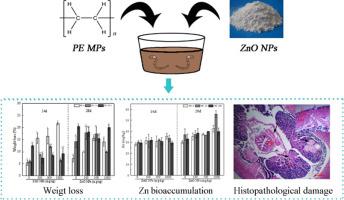Applied Soil Ecology ( IF 4.8 ) Pub Date : 2022-03-29 , DOI: 10.1016/j.apsoil.2022.104469 Shuwu Zhang 1 , Shan Ren 1 , Lei Pei 1 , Yuhuan Sun 1 , Fayuan Wang 1

|
With the increasing release of microplastics (MPs) and nanoparticles (NPs) into the environment, there has been a growing concern about the co-occurrence of these emerging contaminants. However, little is known about the co-contamination effects of MPs and NPs on terrestrial organisms. For the first time, we studied the individual and combined effects of polyethylene (PE) MPs (0, 1%, and 10%, w/w) and ZnO NPs (0, 100, 500, and 1000 mg/kg) on earthworms (Eisenia fetida). Compared to the control, PE MPs or ZnO NPs alone increased the weight loss rate and mortality of earthworms, while the combined exposure of PE MPs and ZnO NPs resulted in higher weight loss rate at the 28th day and lower mortality compared to single application. ZnO NPs greatly increased soil available Zn content, with the highest increments by 1000 mg/kg ZnO NPs at the 28th day. Zn content in earthworms was not affected after 14 days of exposure to ZnO NPs, but showed an increasing trend with increasing ZnO NPs after 28 days of exposure. Co-occurring MPs did not affect soil available Zn content, but changed Zn accumulation in earthworms after 28 days of exposure. The highest Zn content (55.6 mg/kg) was observed in the earthworms under the co-exposure to 1% PE and 1000 mg/kg ZnO NPs. Single exposure to PE MPs or ZnO NPs caused oxidative stress and histopathological damage in the epidermis, intestinal tracts and seminal vesicles. However, co-exposure caused higher CAT and GST activity and MDA content, and more severe histopathological damage, indicating a combined toxicity between them. In conclusion, co-exposure to PE MPs and ZnO NPs caused higher Zn bioaccumulation and more pronounced toxicity response in earthworms, manifesting greater ecological risks. Our findings advance understanding the ecotoxicological risks of co-contamination of MPs and NPs to soil fauna.
中文翻译:

聚乙烯微塑料和氧化锌纳米粒子对蚯蚓 Eisenia fetida 的生态毒理效应
随着微塑料 (MPs) 和纳米粒子 (NPs) 越来越多地释放到环境中,人们越来越担心这些新兴污染物的共存。然而,关于 MPs 和 NPs 对陆地生物的共同污染影响知之甚少。我们首次研究了聚乙烯 (PE) MPs(0、1% 和 10%,w /w)和 ZnO NPs(0、100、500 和 1000 mg/kg)对蚯蚓的单独和联合影响(恶臭艾塞尼亚)。与对照相比,单独使用 PE MPs 或 ZnO NPs 会增加蚯蚓的体重减轻率和死亡率,而 PE MPs 和 ZnO NPs 的联合暴露导致第 28 天的体重减轻率更高,并且与单独施用相比死亡率更低。ZnO NPs 显着提高了土壤速效锌含量,在第 28 天最高增加了 1000 mg/kg ZnO NPs。ZnO NPs 暴露14 d 后蚯蚓体内Zn 含量不受影响,但暴露28 d 后随着ZnO NPs 的增加呈现增加趋势。共同发生的 MPs 不影响土壤有效锌含量,但在暴露 28 天后改变了蚯蚓体内的锌积累。在共同暴露于 1% PE 和 1000 mg/kg ZnO NPs 的蚯蚓中观察到最高的 Zn 含量 (55.6 mg/kg)。单次暴露于 PE MPs 或 ZnO NPs 会导致表皮、肠道和精囊出现氧化应激和组织病理学损伤。然而,共同暴露导致更高的 CAT 和 GST 活性和 MDA 含量,以及更严重的组织病理学损伤,表明它们之间存在联合毒性。总之,PE MPs 和 ZnO NPs 共同暴露在蚯蚓体内引起更高的 Zn 生物积累和更明显的毒性反应,表现出更大的生态风险。我们的研究结果促进了对 MPs 和 NPs 共同污染土壤动物群的生态毒理学风险的认识。PE MPs 和 ZnO NPs 共同暴露在蚯蚓体内引起更高的锌生物累积和更明显的毒性反应,表现出更大的生态风险。我们的研究结果促进了对 MPs 和 NPs 共同污染土壤动物群的生态毒理学风险的认识。PE MPs 和 ZnO NPs 共同暴露在蚯蚓体内引起更高的锌生物累积和更明显的毒性反应,表现出更大的生态风险。我们的研究结果促进了对 MPs 和 NPs 共同污染土壤动物群的生态毒理学风险的认识。











































 京公网安备 11010802027423号
京公网安备 11010802027423号